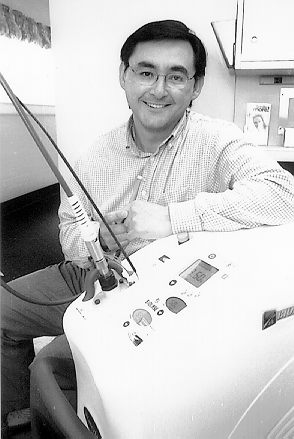
|
 |
||
|
|
Whiter Teeth, Quickly and Predictably With Lasers
In laser whitening, your teeth are cleaned to remove plaque. Then a peroxide-based gel is applied, followed by laser light. The procedure takes between 30 to 45 minutes and offers immediate results. Although it may take more than one session to achieve the desired level of bleaching, this is very uncommon and can usually be completed with an at-home kit rather than another session in the dental office. So how does laser whitening work? First of all, the whitening
gel is very potent. Whereas take home kits There are newer light sources which have come onto the market using what some doctors incorrectly advertise as laser whitening. In fact, these are plasma arc lamps and are not lasers at all. The sole reason for the plasma arc lamp, which is a very intense light, is to heat the whitening gel while in contact with the teeth. Because of the potential to burn the skin, cocoa butter, tanning cream or vitamin E is usually placed on the skin around the mouth to minimize the burn. The procedure lasts considerably longer than with a laser, because the light activation takes twice as long. Clinically, the whitening results between the laser and plasma arc systems are comparable, and cost of treatment is usually the same as well. The biggest difference is that laser whitening takes much less time and therefore is more comfortable to the patient. There are over-the-counter options available for tooth whitening. However, because they are intended to be used in an unsupervised fashion, to avoid the potential for serious damage to the teeth and gums, the whitening agents they contain are significantly weaker than those that can be obtained through a dental professional. Therefore, the results you might expect from these products are significantly limited as well. No matter which method you choose, how white your teeth will get depends on what color they are to begin with and the source of the discoloration. Yellow teeth (often the result of superficial staining caused by smoking, coffee, and tea) will usually get significantly whiter. Gray teeth (caused not by stains but by pigment deep inside the tooth) will lighten to a lesser degree. The most common side effect of any bleaching procedure is sensitivity to hot and cold, but that typically lasts for only about a day. With proper aftercare, whitened teeth can stay bright for up to three and a half years. To keep your smile bright as long as possible, try these easy tips: Follow the "white teeth diet." Drink white wine instead of red wine, and grapefruit juice instead of cranberry juice. Cut back or eliminate the consumption of coffee and tea. Also helpful is to use a "whitening" toothpaste with a mild abrasive on a daily basis.
|
Laser Dr.Christopher walinski, dr Christopher walinski, Laser Tooth Whitening, Bangkok, Cosmetic Dentistry, Dental clinic, Dentist in Bangkok Thailand
| |
|
 typically provide
a gel with a 5 to 10 percent concentration, laser whitening gel
is more often in the range of 35 to 40%. Placing this gel onto
the tooth surface would whiten teeth even without a laser light.
So why the need for the laser? The simple answer is speed. We
are aware that chemical reactions occur more quickly in the presence
of heat. The laser offers us two advantages in this regard. Although
it is not hot, the gentle warmth of the specially-equipped laser
light speeds the whitening process. In addition, the specific
wavelength of laser light is used to initiate photoreceptors
for the chemical reaction that produces the whitening effect
more quickly and more deeply. In other words, the effect lasts
longer using a laser.
typically provide
a gel with a 5 to 10 percent concentration, laser whitening gel
is more often in the range of 35 to 40%. Placing this gel onto
the tooth surface would whiten teeth even without a laser light.
So why the need for the laser? The simple answer is speed. We
are aware that chemical reactions occur more quickly in the presence
of heat. The laser offers us two advantages in this regard. Although
it is not hot, the gentle warmth of the specially-equipped laser
light speeds the whitening process. In addition, the specific
wavelength of laser light is used to initiate photoreceptors
for the chemical reaction that produces the whitening effect
more quickly and more deeply. In other words, the effect lasts
longer using a laser.